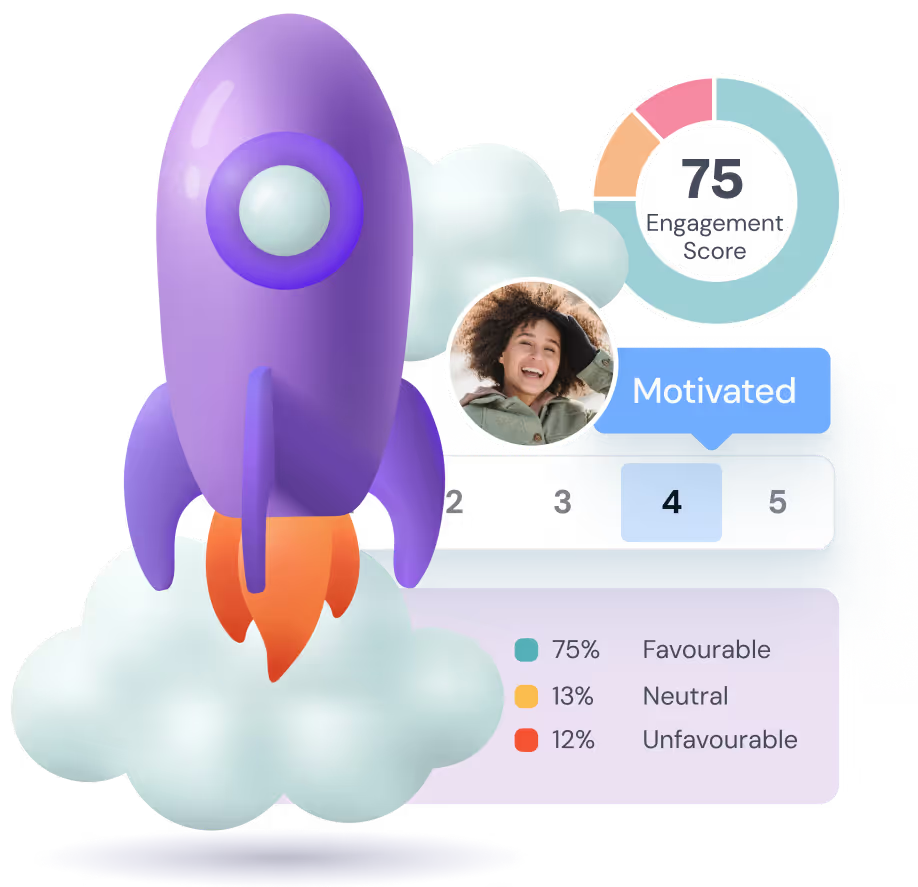Employee engagement is a crucial element of a company's success. It increases motivation, productivity, and profitability, which in turn improves business outcomes.
In order to maximize employee potential and promote business success, it is essential to measure employee engagement. However, not many companies are clear with the tools and methodologies that serve as excellent ways to measure employee engagement.
By the end of this post, you'll have a better understanding of how to measure employee engagement and create a more engaged and motivated workforce. Here's what we'll cover,
Employee engagement is the amount of commitment and dedication that employees have toward their roles. Engaged employees are generally more productive and happier at work. Here are 8 signs of an engaged employee.
- They're innovative
- Engaged employees have the desire to grow and develop themselves.
- They go the extra mile.
- They're more invested and productive.
- If they're leaders, they are approachable and empathetic.
- They're adaptable.
- They provide regular feedback.
- They're more collaborative.
Employee engagement can be defined in many ways, but one quote that sums it up well comes from Virgin Group founder Richard Branson.
He said, "Engage your employees and see your company soar."
You can’t improve what you don’t measure. The same goes for employee engagement. Measuring engagement helps you understand how emotionally connected your people are to their work, their team, and your organization’s mission.
Engagement might sound subjective — and to an extent, it is. But with the right tools, you can measure it in reliable, consistent ways. Surveys, pulse checks, and sentiment analytics reveal how engaged employees feel, how motivated they are, and where friction exists across teams.
When you measure engagement regularly, patterns start to emerge. You’ll see which departments are thriving, which teams are disengaged, and what’s driving those differences. These insights help HR leaders make informed decisions — whether that’s improving leadership communication, addressing burnout, or reshaping recognition programs.
There are several metrics that organizations can use to measure employee engagement. Here are some common ones:
Engagement Index
This parameter evaluates the overall level of engagement among employees in an organization. It's usually calculated based on the results of employee engagement surveys and other feedback tools.
Turnover Rate
This particular metric measures the number of employees who leave an organization over a certain period of time. High turnover rates can indicate low engagement levels and dissatisfaction among employees.
Absenteeism Rate
It is the number of employee absences over a certain period. High absenteeism rates can be a sign of low engagement levels and employee dissatisfaction.
Employee Net Promoter Score (eNPS)
This measure evaluates the allegiance of employees and their ability to endorse the organization to others. It is assessed by inquiring whether employees would suggest the company to others on a rating scale of 0 to 10.
Employee Satisfaction
This indicator assesses how satisfied workers are with their jobs in terms of pay, perks, job security, and workplace culture.
Keeping Staff Around
It evaluates the proportion of workers who have been with an organisation throughout time. A high retention rate may be a sign of highly engaged and content workers.
Performance and Productivity Metrics
Consistent underperformance or a decline in productivity can be symptoms of low engagement.
Employee Recognition Rate
The frequency and distribution of recognitions can gauge the vibrancy of your company’s culture and how valued employees feel.
Survey Participation Rate
The willingness of employees to participate in engagement surveys itself reflects their level of engagement and investment in the company.
Let us have a look at some of the top ways that several organizations use to measure their employees' engagement.
1. Employee Engagement Surveys
This is a common and one of the best ways to measure your employees' engagement levels.
These employee engagement surveys can be conducted annually, quarterly, or monthly and can include questions about job satisfaction, employee motivation, and workplace culture. These surveys may not accurately reflect the mindset of the employees, but with the right employee engagement tool, you can obtain a close enough outline on their engagement.
These surveys are longer than pulse surveys.
2. Pulse Surveys
Pulse surveys are smaller and short variations of surveys that are conducted more frequently. They are mostly distributed on a weekly, monthly, or quarterly basis.
They typically consist of 5-15 questions that focus on specific topics, drivers, or reporting factors.
With pulse surveys, organizations can measure the results of their current engagement efforts and compare them to the previous employee engagement survey results to see what's working and where else they can improve.
3. Focus Groups
Focus groups are small, moderated discussion groups that can be used to gather qualitative feedback from employees about their engagement levels.
Its' a great way to measure employee engagement without surveys.
Qualitative feedback usually comprise of detailed answers as compared to close-ended answers like the ones you see on surveys.
Collect qualitative data from a group with similar experiences. Provides insight into how employees feel about their work, workplace, and overall experience with the company. Identifying areas for improvement in employee engagement can improve productivity, job satisfaction, and retention.
4. Individual Meetings
Employees might be personally interviewed by managers to discuss engagement and pinpoint opportunities for development. Commonly known as one-on-ones, these meetings can also be done through video calls.
As a result, they have a personal connection to the business and are able to work more passionately. Employees are free to speak openly, express their actual ideas, and provide thoughtful responses.
5. Analysis of Social Media
Analyzing engagement on social media platforms, where employees interact with the company's posts or share their own thoughts about the organization, offers valuable insights into employee engagement.
Additionally, tracking email and newsletter engagement, such as open rates and click-throughs, helps identify employees who are actively interested in company updates and more likely to engage with company initiatives.
6. Employee Net Promoter Score (eNPS)
Employee Net Promoter Score (eNPS) is a metric used by organizations to measure employee loyalty and satisfaction. This evaluation model categorizes employees into three categories: promoters, passives, and detractors.
Promoters are highly satisfied employees who are likely to recommend the organization as a great place to work. In contrast, detractors are those who are unhappy and could potentially discourage others from joining the organization. Passives fall in the middle, indicating employees who are satisfied with their job but do not exhibit strong loyalty or enthusiasm towards the company.
7. Exit Interviews
Conducting exit interviews with employees who are leaving the company offers a unique opportunity to gather honest feedback about their experience, including factors that influenced their engagement and decision to leave. These insights can highlight areas of improvement for the organization to enhance employee retention and engagement.
8. Employee Recognition Programs
These programs can provide insight into employee engagement levels by tracking employee participation and engagement in recognition activities. Because becoming unrecognized even after working regularly in a busy schedule is easy and this situation can be avoided by employee recognition programs.
Navigating through the landscape of employee engagement, these tools offer a comprehensive approach to understanding and enhancing the workplace environment, seamlessly integrating into the overarching goal of fostering a vibrant, engaged, and highly productive workforce.
1. Employee Engagement Software
Engagement software is designed to foster a more connected and motivated workforce by facilitating communication, feedback, and recognition within an organization.
It offers features like surveys, polls, and social recognition boards to help companies understand and improve employee engagement levels. This type of software often includes gamification and rewards to make participation enjoyable and rewarding for employees, ultimately aiming to boost morale and productivity.
2. Employee Feedback Tool
An employee feedback tool is a digital platform that enables continuous and anonymous feedback, allowing employees to share their thoughts and suggestions with management without fear of repercussion ( typically through anonymous surveys).
These tools support regular check-ins, pulse surveys, and open forums, making it easier for companies to gather actionable insights and promptly address any concerns. By streamlining the feedback process, organizations can create a culture of openness and continuous improvement.
3. Peer-Recognition Platform
A peer-recognition platform empowers employees to acknowledge and celebrate their colleagues' achievements and contributions. These platforms can range from simple digital "thank you" cards to more complex systems that include point-based rewards and leaderboards. Recognizing peers not only boosts the morale of the recipient but also fosters a positive work environment, encouraging teamwork and collaboration.
4. Performance Management Software
Performance management software streamlines the goal-setting, tracking, and appraisal process, aligning individual performance with organizational objectives.
It streamlines performance reviews, facilitates real-time feedback, and assists managers with creating personalized development plans, thus focusing on the employees' growth and achievement.
By automating and organizing performance data, this software enables more accurate assessments and supports data-driven decisions.
ThriveSparrow's AI-based PDPs can save your manager's time and effort while reviewing multiple reports.

5. Analytics and Dashboards
Analytics and dashboards in the context of employee engagement offer real-time insights into workforce trends, behaviors, and sentiments. These tools aggregate data from various sources, such as engagement surveys, performance metrics, and social recognition activities, to provide a comprehensive view of engagement levels across the organization. With customizable dashboards, leaders can identify patterns, monitor the impact of initiatives, and make informed decisions to enhance employee engagement and organizational performance.
How ThriveSparrow Makes Measuring Employee Engagement Easier
ThriveSparrow stands as a comprehensive platform designed to revolutionize employee engagement and performance management.
It brings together a suite of tools, including engagement software for fostering a connected workforce, employee feedback tools for continuous insights, peer-recognition platforms for celebrating achievements, and performance management software for aligning individual goals with organizational objectives.
its core, ThriveSparrow's AI-based Personal Development Plans (PDPs) simplifies creating tailored growth strategies, saving management time and enhancing employee development.
Coupled with analytics and dashboards, ThriveSparrow provides real-time insights into engagement trends, making it the go-to solution for companies aiming to nurture a vibrant and productive workplace.
Wrapping Up
Any company's ability to succeed is greatly influenced by how committed its staff is. Employee engagement increases motivation, productivity, and engagement, which improves company outcomes. Surveys, focus groups, social media analytics, and performance measurements are just a few of the methods and measures they can utilise.
Armed with these insights, businesses can take action to improve engagement levels and create a positive workplace culture that attracts and retains top talent. By investing in their employees' engagement, companies can unlock their potential and achieve long-term success.
















